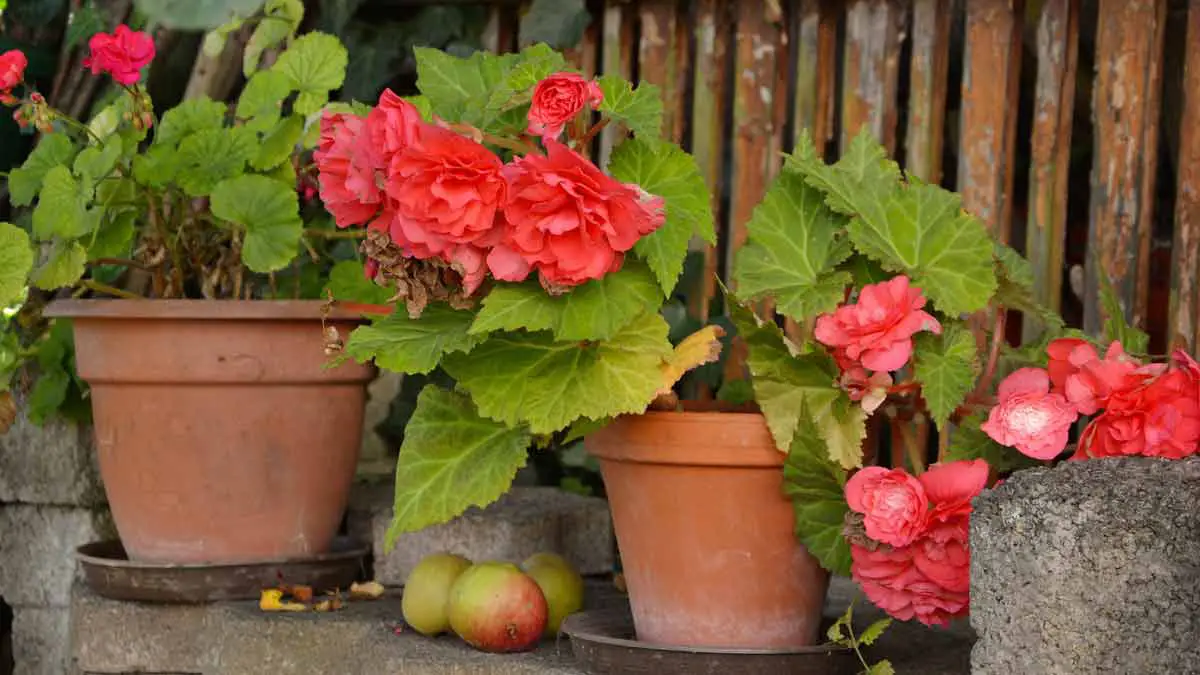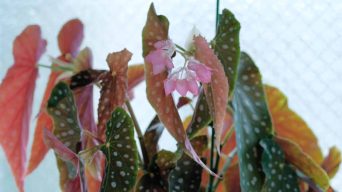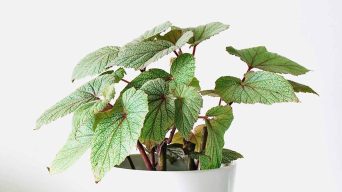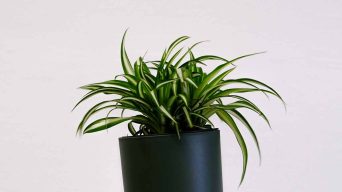Begonia plants are beautiful, easy to care for, and make excellent houseplants.
They come in various colors, shapes, and sizes and have something to offer to everyone.
But what do you do when you notice your begonia wilting?
There are a few things that could be causing your plant to wilt, and luckily, there are also a few easy solutions.
Here you’ll find the most common reasons begonias wilt and what you can do to fix the problem.
Why Is My Begonia Wilting and What Can I Do About It?
There are a few reasons your begonia plant could be wilting.
That’s why it’s essential to take a closer look at your plant and see if you can identify the problem.
Once you know what’s causing the issue, you can take the necessary steps to fix it.
1. Not Enough Water
If your begonia isn’t getting enough water, it will start to wilt.
This is the most common reason for begonias to wilt, so it’s an excellent place to start.
The lack of water can be caused by several things, including incorrect watering, poor drainage, or extreme heat.
When a plant doesn’t get enough water, it starts to wilt to conserve moisture.
How To Tell If Your Begonia Is Wilting Due To Lack Of Water
A few signs will help you tell if your begonia is wilting due to lack of water.
These include:
- The leaves will start to droop and look limp
- The leaves will turn yellow or brown
- The stem will begin to shrivel
- The soil will be dry and crumbly
If you think your begonia is wilting due to lack of water, the first thing you should do is check the soil.
Stick your finger about an inch into the soil and see if it feels dry.
If it does, it’s time to water your plant.
How To Treat A Wilting Begonia Due To Lack Of Water
If you think your begonia is wilting due to lack of water, the best thing to do is give it a good watering.
To water a wilting plant, soak the soil until it’s saturated and let the excess water drain away.
Be sure to empty any water that collects in the saucer beneath the pot.
Once you’ve watered your plant, it’s essential to keep an eye on it and water it as needed.
In general, begonia plants need to be watered about once a week.
However, this can vary depending on the plant type, the pot size, and the climate.
2. Overwatering
While it’s essential to ensure your begonia gets enough water, it’s also important not to overwater it.
Excessive watering of Begonia plants may result in various issues, such as the development of root rot and susceptibility to fungal diseases.
It can also cause the begonia leaves to turn yellow, the stem to rot, and the plant to wilt.
Overwatering can result from incorrect watering, poor drainage, or too much humidity.
How To Tell If Your Begonia Is Wilting Due To Overwatering
A few signs will help you tell if your begonia is wilting due to overwatering.
These include:
- The leaves will start to turn yellow or brown
- The leaves will begin to drop off
- The stem will start to rot
- The soil will be soggy or muddy
- The plant will be wilting even when the soil is moist
- The roots will be black or brown
If you think your begonia is wilting due to overwatering, the first thing you should do is check the soil.
Stick your finger about an inch into the soil and see if it feels soggy or wet.
If it does, it’s time to stop watering your plant.
How To Treat A Wilting Begonia Due To Overwatering
If you think your begonia is wilting due to overwatering, you should first stop watering it.
Let the soil dry out thoroughly before you water your plant again.
Check the soil every few days to see if it’s dry.
Once the soil is dry, you can start watering your plant again.
However, be sure to water it less often than you did before.
Ensure that the pot has good drainage so water can drain away quickly.
You may also want to consider repotting your plant in a pot with drainage holes and using a well-draining potting mix.
3. Low Humidity
Another common reason for begonias to wilt is low humidity.
Begonias are native to tropical climates and prefer high levels of humidity.
If the air is too dry, it can cause the plant to wilt.
Begonias need humidity levels of at least 50%.
However, they can tolerate lower levels if kept in a pot with moist soil.
How To Tell If Your Begonia Is Wilting Due To Low Humidity
A few signs will help you tell if your begonia is wilting due to low humidity.
These include:
- The leaves will start to turn brown or crispy
- The leaves will fall off
- The plant will stop growing
- The flowers will drop off
How To Treat A Wilting Begonia Due To Low Humidity
If you think your begonia is wilting due to low humidity, you can do a few things to increase the humidity around your plant.
One way to do this is to mist your plant with water daily.
You can also place your plant on a pebble tray. This is a tray filled with pebbles and water.
The water will evaporate and increase the humidity around your plant.
You can also use a humidifier to increase the humidity in the room.
If you group your plants, they will also create their own microclimate and increase their humidity.
4. Too Much Sunlight
While begonias need some sunlight to grow, too much sunlight can cause them to wilt.
Begonias grown in pots should be placed in an area with bright, indirect light.
If placed in direct sunlight, the leaves will start to turn yellow, and the plant will wilt.
How To Tell If Your Begonia Is Wilting Due To Too Much Sunlight
A few signs will help you tell if your begonia is wilting due to too much sunlight.
These include:
- The leaves will start to turn yellow
- The tips of the leaves will begin to turn brown or black
- The leaves will be dry and crispy
- The plant will stop growing
How To Treat A Wilting Begonia Due To Too Much Sunlight
If you think your begonia is wilting due to too much sunlight, the first thing you should do is move it to an area where it will get less direct sunlight.
An east- or west-facing window is a good option. This will allow your plant to get sunlight without being in direct sunlight.
You can also use a sheer curtain to filter the sunlight.
Outdoors, you can place your plant in a spot that gets partial shade, such as under a tree.
5. Lack of Light
While begonias need some sunlight to grow, they can also wilt if they don’t get enough light.
If a begonia isn’t getting enough light, the leaves will turn yellow, and the plant will stop growing.
Light is essential for begonias to photosynthesize and create food for the plant.
When a begonia doesn’t get enough light, it will wilt as the plant tries to conserve energy.
How To Tell If Your Begonia Is Wilting Due To Lack Of Light
A few signs will help you tell if your begonia is wilting due to lack of light.
These include:
- The leaves will start to turn yellow
- The plant will stop growing
- The stems will become leggy
- There will be fewer flowers
How To Treat A Wilting Begonia Due To Lack Of Light
If you think your begonia is wilting due to lack of light, the first thing you should do is move it to an area where it will get more light.
An east- or west-facing window is a good option. This will give the plant enough light to grow without direct sunlight, which can be too harsh.
If you can’t move your begonia, use grow lights. These will provide the plant with the extra light it needs to grow.
6. Overfertilizing
Overfertilizing is another common reason why begonias will wilt.
When a plant is overfertilized, the roots can’t take up enough water, and the plant will wilt.
This is a common problem when people use too much fertilizer or fertilizer that is too high in nitrogen.
How To Tell If Your Begonia Is Wilting Due To Overfertilizing
A few signs will help you tell if your begonia is wilting due to overfertilizing.
These include:
- The leaves will start to turn yellow
- The leaves will be dry and crispy
- The plant will stop growing
- The roots will be brown and mushy
How To Treat A Wilting Begonia Due To Overfertilizing
If your begonia is wilting due to overfertilizing, you should first flush the soil.
To do this, water the plant until the water runs out of the bottom of the pot. This will help to remove any excess fertilizer from the soil.
You should also stop fertilizing the plant until it recovers. Once it does, you can start fertilizing again, but use a light hand.
7. Excessive Heat
While begonias prefer warm weather, they can also wilt if it gets too hot.
If the temperature gets above 90 degrees Fahrenheit, the plant leaves will start to turn yellow, and the plant will wilt.
This is because the plant is trying to conserve water in the heat.
How To Tell If Your Begonia Is Wilting Due To Excessive Heat
A few signs will help you tell if your begonia is wilting due to excessive heat.
These include:
- The leaves will start to turn yellow
- The leaves will be dry and crispy
- The tips of the leaves will begin to turn brown or black
- The plant will stop growing
How To Treat A Wilting Begonia Due To Excessive Heat
If you think your begonia is wilting due to excessive heat, the first thing you should do is move the plant to a cooler location.
If possible, try to find a spot out of direct sunlight.
You should also make sure the plant has enough water.
The soil should be moist but not soggy.
If the soil is too dry, the plant will wilt even more.
You may also want to mist the plant with water to help keep it cool and hydrated.
8. Pest Infestation
Pests can also cause begonia wilting.
Common pests that affect begonias include aphids, whiteflies, and mealybugs.
These pests suck the sap from the plant, which can cause the plant to wilt.
Pest infestations can also lead to other problems, such as leaf drop and yellowing leaves.
How To Tell If Your Begonia Is Wilting Due To A Pest Infestation
A few signs will help you tell if your begonia is wilting due to a pest infestation.
These include:
- The leaves will have small, raised bumps
- The leaves will have a stippled or yellowed appearance
- The leaves will be covered in a sticky substance
- The leaves will be curled or distorted
- You will see tiny insects on the leaves or stems
How To Treat A Wilting Begonia Due To A Pest Infestation
If you think your begonia is wilting due to a pest infestation, you should first isolate the plant.
This will help to prevent the pests from spreading to other plants.
Next, you will need to remove the pests from the plant.
This can be done by hand or with a hose.
To remove them by hand, wipe them off with a damp cloth.
If you are using a hose, direct the water to the underside of the leaves, as this is where most of the pests will be hiding.
Once the pests are gone, you should treat the plant with an organic insecticide.
You can use a commercial product or make your own by mixing 1 part neem oil with 1 part water.
9. Diseases
Diseases can also be a cause of begonia wilting.
Common diseases that affect begonias include root rot, powdery mildew, and stem rot.
Root rot is caused by a fungus attacking the Begonia plant’s roots. This can cause the plant to wilt and eventually die.
Powdery mildew is a fungal disease that affects the leaves of the plant. It causes the leaves to become covered in a white, powdery substance.
Stem rot is another fungal disease that affects the stems of the plant. This can cause the stems to become soft and mushy.
How To Tell If Your Begonia Is Wilting Due To A Disease
A few signs will help you tell if your begonia is wilting due to a disease.
These include:
- The leaves will have spots or lesions
- The leaves will be yellow or brown
- The leaves will be wilted or drooping
- The stems will be soft or mushy
- The roots will be black or discolored
How To Treat A Wilting Begonia Due To A Disease
If you think your begonia is wilting due to a disease, you should first isolate the plant.
This will help to prevent the disease from spreading to other plants.
Next, you will need to remove the affected parts of the plant.
You can prune the leaves with a sharp knife if the leaves are affected.
If the stems are affected, you can cut them off with pruning shears.
Once the affected parts of the plant have been removed, you should treat the plant with a natural fungicide.
Several commercial products are available, or you can make your own by mixing 1 part milk with 1 part water.
How To Prevent Your Begonia From Wilting
The best way to prevent your begonia from wilting is to give it the proper care it needs.
The first step is to make sure you are watering your begonia properly. Allow the soil to dry out between waterings, and never let your begonia sit in water.
If your begonia is starting to wilt, immediately check the soil moisture and water as needed.
It’s also essential to give your begonia the proper amount of light. Begonias need bright indirect light to thrive.
If you notice your begonia wilting in the sun, move it to a shadier spot. However, if you see it wilting in low light, try moving it to a brighter location.
Finally, ensure you fertilize your begonia regularly during the growing season. Use a balanced fertilizer and follow the directions on the package.
Following these simple tips can help prevent your begonia from wilting.
Final Thoughts
If you notice your begonia wilting, it’s essential to figure out the cause so you can take steps to revive your plant.
In most cases, wilting is caused by too little water, too much sun, or pests.
By taking a closer look at your plant and making some adjustments to its care routine, you can help your begonia recover and prevent further problems.







